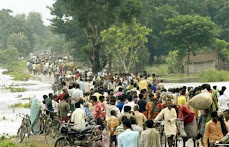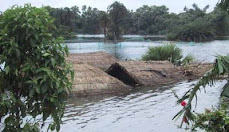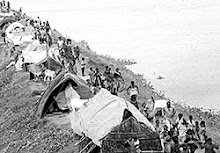Initiating a structured discussion on the Ganga river basin-covering parts of Nepal, India, Tibet and Bangladesh- wherein approximately one in twelve people in the world live, considered submission of 400/500 words are invited from a holistic perspective to comprehend and articulate the crisis that has emerged from the current fragmented and fractured approach of the governments, academia, civil society and corporations of commerce and religion.
Being a moderated discussion, participants are expected to stay focused around the lead questions:
What is Ganga River Basin approach? Does it apply to only 79% of Ganga basin, which is in India? Will it include 13 % of Ganga basin that is in Nepal, 4 % in Bangaldesh and 4 % in Tibet? What is its relationship with the river systems and with the composite Ganga-Brahmputra-Meghna basin and its consequences?
How does it affect the policies of Industry, Power, Agriculture, Urban Development, Health and Environment by the central government, the governments of eleven states (Bihar, Chhattisgarh, Haryana, Himachal Pradesh, Jharkhand, Madhya Pradesh, NCT of Delhi, Rajasthan, Uttranchal, Uttar Pradesh and West Bengal), the neighboring countries and industry bodies like CII/FICCI/ASSOCHEM/PHCCI?
What is the relevance of Ganga River basin approach when the river channel has been amputated from the flood plains besides the amputation of the river channel itself?
Will the Third Phase of Ganga Action Plan (GAP) or the proposed the Ganga River Basin Authority which is to consider its formation in a meeting likely to be held on January 15 and its proposed river basin approach affect the quality of surface water, ground water and the survival of natural flow of the rivers in the basin? (The GAP-I which was to be completed by March 1990 was extended till March, 2000 when it was declared complete but Phase I of the Plan is not yet fully complete and GAP-II which was to be completed in 2001 was extended till December 2008. This too remains incomplete)
What is the meaning of the official ceremonial and ornamental status being accorded to Ganga just prior to the upcoming parliamentary elections?
Which among the following are the biggest threats to Ganga basin?
a. National Interlinking of Rivers project of NDA & UPA,
b. UP’s Ganga Expressway project,
c. Uttarakhand’s Bhairon Ghati, Loharinag-Pala, Pala Maneri and Maneri Bhali hydro-projects
d. Some 191 heavily polluting industries in the Ganga basin states
e. West Bengal’s Farraka Barrage
f. Bihar’s Interlinking of Rivers project or Kosi High Dam
g. Pollution from “Religious” Activities
h. Corporate funding of political parties
i. Co-opted NGOs
What is required is not yet another Authority but genuine basin approach to overcome these threats.
Given the significance of the discussions, general submissions to the list will be held back (only most important submissions will get posted).
Historically, floods and their control have never been a big issue in the Ganga-Brahmaputra basin, as it is today. Floods became a major issue after the British occupied India. When they examined the Ganga basin, they believed that if it could be made “flood-free”, they could levy a tax in return for such protection.
Tuesday, 6 January 2009
Subscribe to:
Post Comments (Atom)








No comments:
Post a Comment